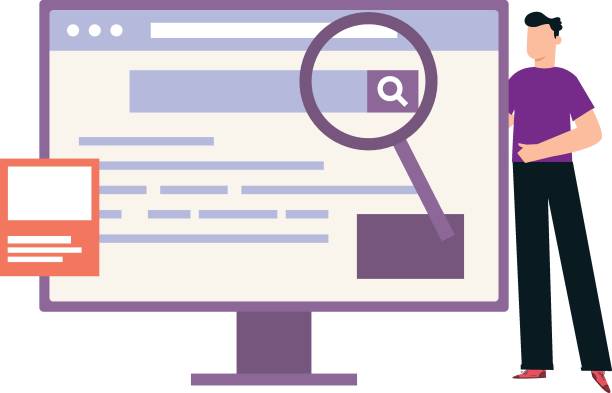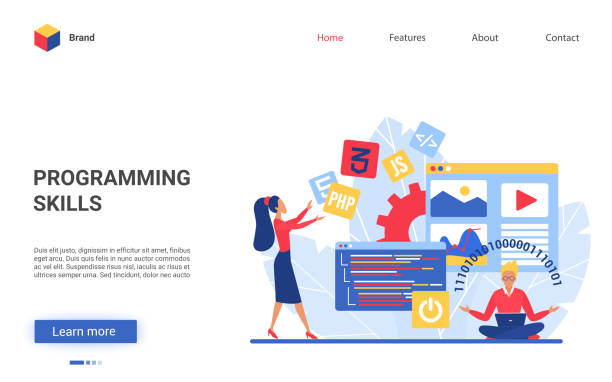Introduction and Importance of Multilingual Website Design in Today’s World

In today’s interconnected world, the expansion of global markets and access to international audiences has become an undeniable necessity for businesses.
#Multilingual_website_design is no longer merely a competitive advantage, but rather the cornerstone of an effective presence in the global digital arena.
When you are able to communicate with your audience in their native language, you will build greater trust and experience higher conversion rates.
This approach also requires a deeper understanding of the local culture and needs of each region, which goes beyond mere word translation.
The importance of this issue is such that many leading companies make significant investments in this area.
A successful multilingual site not only breaks geographical boundaries but also allows you to introduce your products and services to a wider range of potential customers.
This is particularly crucial for businesses seeking export opportunities or those with audiences in various countries.
Imagine your website being available only in Persian; in that case, millions of people worldwide who are looking for your services or products but are not proficient in this language would be excluded from your audience.
This is where designing a multilingual website emerges as a key strategy for international development.
In fact, this is a form of investment in the future of your business on a global scale.
This article, in an explanatory and guideline format, introduces you step-by-step to the principles and challenges of multilingual website design.
From choosing the right platform to SEO strategies and content management, we will cover all vital aspects of this process.
The goal is for you to be able to make the best decisions for your website with comprehensive and practical information and have a stronger presence in global markets.
This guide will help you build not just a website, but a strong communication bridge with your international audience and pave the way for sustainable growth.
Does your company’s website create a professional and lasting first impression in the minds of potential customers? Rasaweb, with its professional corporate website design, not only represents your brand’s credibility but also opens a path for your business growth.
✅ Create a powerful and trustworthy brand image
✅ Attract target customers and increase sales
⚡ Get Free Consultation
Challenges and Opportunities Ahead in Multilingual Site Implementation

Implementing multilingual website design, despite the countless opportunities it offers, also presents its own challenges that must be carefully considered.
One of the biggest challenges is managing the technical complexities related to international SEO.
The correct use of Hreflang tags to indicate the relationship between different language versions of a page is crucial.
Incorrect implementation of these tags can lead to serious problems in your site’s ranking in search results.
Also, the issue of Right-to-Left (RTL) or Left-to-Right (LTR) languages, which is required for example in Persian and Arabic, complicates user interface design.
These specialized issues require sufficient knowledge and experience in web development.
The opportunities provided by a multilingual site often outweigh its challenges.
Entering new markets, increasing organic traffic, and building credibility as a global brand are just some of these opportunities.
However, it should be noted that merely translating text is not enough.
Content localization, meaning adapting content to the culture, local idioms, and even the currency and dating system of each region, is of high importance.
This approach not only improves user experience but also strengthens a sense of closeness and trust in the audience, which itself is a great opportunity for multilingual website design.
Furthermore, choosing subdomains, subdirectories, or country-code top-level domains (ccTLDs) for the URL structure of multilingual sites is an important decision that affects SEO and site management.
Each of these options has its pros and cons, and their selection depends on your business’s overall goals and strategy.
Managing content in multiple languages is also challenging; ensuring content is up-to-date and consistent across all language versions requires a robust Content Management System (CMS) and defined processes.
All these points, both challenges and opportunities, must be carefully considered during the planning phase of multilingual website design to ensure project success and prevent resource waste.
Principles for Choosing a Content Management System (CMS) and URL Structure for Multilingual Sites

Choosing the right Content Management System (CMS) is one of the most crucial decisions in a #multilingual_website_design project.
A powerful CMS should offer seamless localization and multilingual management capabilities.
WordPress with plugins like WPML or Polylang, Drupal with its powerful localization capabilities, and Joomla are all popular options.
Each has its specific advantages and disadvantages; for instance, WordPress is suitable for many businesses due to its ease of use and large support community, whereas Drupal is more effective for large and complex projects with more specialized needs.
When choosing a CMS, pay attention to the ease of managing translations, RTL support, and compatibility with multilingual SEO.
This is an instructive decision that must be made carefully.
The URL structure also plays a key role in multilingual website design.
There are three main approaches: using country code top-level domains (ccTLDs) like .de for Germany or .fr for France, which helps with local SEO but managing and maintaining multiple domains can be costly; using subdirectories like yoursite.com/en or yoursite.com/fa, which is the most common and popular method and is relatively easy to manage; and using subdomains like en.yoursite.com or fa.yoursite.com, which is often used for complete separation of linguistic content and can help with local SEO but might be considered separate sites by Google.
The choice of URL structure should be based on SEO goals and the ease of future site management.
Below is a comparative table between Content Management Systems and URL structure options for multilingual website design.
This table helps you make a more informed decision and choose the best option for your specific needs.
Each method has its own implications in terms of SEO, hosting, and management, which are noted in this table.
This guidance will provide practical information for your project planning phase and pave the way for a successful implementation.
| Factor | WordPress (WPML/Polylang) | Drupal | Subdirectory | Subdomain | Country Code Top-Level Domain (ccTLD) |
|---|---|---|---|---|---|
| Implementation Complexity | Medium (with plugin) | High (native) | Medium | Medium | High |
| Maintenance Cost | Low to Medium | Medium to High | Low | Medium | High (multiple domains) |
| Impact on Local SEO | Good | Good | Medium | Good | Excellent |
| Easy Translation Management | Depends on plugin | Native and strong | Depends on CMS | Depends on CMS | Depends on CMS |
SEO Optimization for Multilingual Sites

Search Engine Optimization (SEO) in multilingual website design has dimensions beyond traditional SEO.
#Multilingual_SEO requires special attention to technical, content, and link-building factors to ensure your website is displayed correctly in search results for each target language and region.
The first step is local keyword research in each language.
Words that are popular in one language may have less meaning or search volume in another.
This stage requires a deep understanding of the local culture and how local users search, which is why it has an analytical nature.
After identifying keywords, correct implementation of the Hreflang tag is of high importance.
This tag informs search engines that different language versions of a page are available and helps prevent duplicate content issues.
Also, using multilingual sitemaps that include all URLs for different language versions is essential to ensure proper crawling by search engines.
In the multilingual website design process, these technical measures play a fundamental role in your website’s visibility and require a specialized approach.
Link building must also be done carefully.
Building quality backlinks from local and reputable websites in each country or region sends a strong signal to search engines that your website is credible and relevant for that specific market.
Furthermore, website content must be fully localized and appear natural; machine translations often lack the necessary quality and can harm SEO rankings.
Finally, continuous monitoring of SEO performance in each language and making necessary adjustments based on analytical data are vital for maintaining and improving site rankings in search engines.
This comprehensive approach to multilingual SEO will be the foundation for long-term success in multilingual website design and expanding your online presence worldwide.
How much does losing business leads due to an unprofessional website cost you? Solve this problem forever with professional corporate website design by Rasaweb!
✅ Increase credibility and trust of potential customers
✅ Easier attraction of new business leads
⚡ Get a free consultation right now!
Quality Content and Translation Management

The quality of content and its translation process is the beating heart of success in #multilingual_website_design.
Simply translating words from one language to another is not enough; content must be localized to align with the culture, customs, and even slang of each region.
This means going beyond word-for-word translation and having a deep understanding of the target audience.
For example, an advertising slogan that is highly successful in one culture might be meaningless or even offensive in another.
Therefore, this part of multilingual website design highly requires a specialized approach.
Using native translators specializing in your business field is one of the most important strategies to ensure high-quality translations.
These translators are not only fluent in the language but also familiar with subtle cultural differences and specific industry terms.
Creating a Glossary and Translation Memory to maintain consistency in future translations, especially in large projects, is very useful.
These tools not only guarantee quality but can also help reduce translation costs and time.
The content management process should also be designed in such a way that updating and maintaining content in all languages is easily possible.
A Content Management System (CMS) with strong multilingual capabilities simplifies this process.
Also, defining clear responsibilities for each language, including content review and publishing, is essential to prevent disorganization.
The goal is for your website visitors, regardless of the language they view the content in, to feel that the content has been created specifically for them, not merely translated.
This level of guidance and precision in content and translation management will be the distinguishing factor between an ordinary multilingual site and a successful global one.
The Role of Artificial Intelligence and Modern Tools in Multilingual Design

Modern technologies, especially Artificial Intelligence (AI), are significantly transforming the field of #multilingual_website_design and translation processes.
While traditional machine translation often suffered from deficiencies in accuracy and localization, recent advancements in Deep Learning and Natural Language Processing (NLP) have led to Neural Machine Translation (NMT) tools that provide significantly more accurate and natural results.
These tools can serve as a powerful starting point for producing multilingual content, significantly increasing the process speed and reducing costs.
This is good news for multilingual website design developers.
However, it’s important to understand that AI still cannot fully replace human translators, especially for sensitive, specialized, or creative content that requires deep cultural understanding.
The best approach is to use AI as an assistive tool for human translators.
Machine translation tools can provide a preliminary draft, and human translators then take on the task of editing, localizing, and final refining to ensure the accuracy and high quality of the content.
This collaboration between humans and machines is the most optimal way to manage large volumes of multilingual content.
In addition to translation, AI can also be useful in other aspects of multilingual website design.
For example, AI-powered tools can help analyze user data from different regions to identify behavioral patterns and specific needs of each market.
These insights can be used to improve user experience and personalize content for each language.
Furthermore, some platforms are developing automatic language detection and content switching capabilities based on the user’s location, which increases ease of use for visitors.
These news developments indicate a brighter and more efficient future for multilingual web design projects, which are progressing daily.
User Experience (UX) and Responsive Design in Multilingual Sites

User Experience (UX) is of particular importance in #multilingual_website_design because users from different cultures and with varying expectations visit your website.
The user interface must be designed to be fully optimized for all languages and writing directions (such as RTL for Persian and Arabic).
This means adjusting the layout of elements, images, and even the placement of buttons and forms to be compatible with the writing direction.
A poor UX design can quickly drive users away from your website, even if your content is perfectly accurate.
This section requires a specialized and instructive approach.
Another important consideration is Responsive Design.
Given the variety of devices and screen sizes, your website must be displayed optimally on all of them.
This becomes even more critical for multilingual sites, as users from various devices around the world might access your content.
Ensuring that navigation menus, fonts, and images are displayed correctly in every language and on every screen size is essential for providing a seamless and satisfactory user experience.
Furthermore, ensuring fast site loading speed across all geographical regions is also highly important.
Using Content Delivery Networks (CDNs) to cache content on servers closer to users can significantly increase loading speed and improve user experience.
All these details in multilingual website design and its management help create a stable and effective platform for communicating with global audiences.
Below, a table outlining key UX considerations for multilingual sites is provided to help you with better planning.
| UX Factor | Description and Importance | Practical Tip |
|---|---|---|
| Writing Direction (RTL/LTR) | Correct adjustment of layout and elements for right-to-left and left-to-right languages. Failure to observe it leads to UI clutter. |
Use CSS Direction and extensive testing in each language. |
| Language Selector | Placing the language selector in an accessible and clear location. It should not be hidden or difficult to find. |
Usually in the site header or footer with a flag icon or language code. |
| Fonts and Typography | Choosing fonts that support all characters of the target languages and have high readability. | Use Google Fonts or web fonts with broad language support. |
| Images and Visual Content | Images and videos should be appropriate for the local culture and, if necessary, have translated captions or descriptions. | Localize images containing text and culturally review visual content. |
| Fast Loading | Loading speed for users in different geographical regions. Direct impact on user experience and SEO. |
Use CDN and optimize images and scripts. |
Does Every Business Need a Multilingual Website?

This is a key #questionable_content that many businesses face: Is investing in multilingual website design essential for us? The answer to this question depends on several factors, and there’s no definite “yes” or “no.”
For businesses aiming to expand into international markets, or those with customers from different countries, a multilingual website is a necessity.
This is especially crucial for international companies looking to establish deeper connections with global audiences.
However, for a small, local business with no intention of operating beyond domestic borders, investing in multilingual website design might not be economically justified.
Initial development costs, quality translation, and ongoing maintenance can be substantial.
In such cases, it’s better to focus resources on optimizing user experience and SEO in the native language.
Therefore, a comprehensive Cost-Benefit Analysis should be performed.
Another question to ask is: Do our target audiences speak other languages? Analyzing website traffic data, customer demographic information, and even competitor analysis can provide valuable insights.
If a significant portion of your potential audience is located abroad or speaks another language, then a multilingual site can provide an excellent return on investment.
Ultimately, the decision for multilingual website design should be part of your overall business strategy and not merely a fleeting trend.
This analytical approach helps you manage your resources efficiently and achieve your long-term goals.
Does your current corporate website present a worthy image of your brand and attract new customers?
If not, turn this challenge into an opportunity with Rasaweb’s professional corporate website design services.
✅ Significantly improves your brand’s credibility and image.
✅ Paves the way for attracting new leads and customers.
⚡ Contact Rasaweb now for a free and specialized consultation!
Success Stories and Lessons Learned from Large Multilingual Sites

A look at large and successful global companies shows that #multilingual_website_design has played a vital role in their market expansion.
Amazon, Google, and Airbnb are prime examples that, by fully localizing their content and user experience, have managed to achieve leading positions in various countries worldwide.
They don’t just translate content; they adapt it to the specific culture and needs of each region.
This includes textual content, images, currency, and even payment methods.
These success stories are the best lessons for us.
One of the important lessons to learn from these tech giants is the importance of continuous research and analysis.
They are constantly collecting data from their international users to identify strengths and weaknesses and improve their website.
This analytical process includes A/B testing for different language versions, tracking conversion rates, and reviewing user feedback.
They know that a multilingual website is not a one-time project but an ongoing process of optimization and localization.
This approach helps them always be leaders in the multilingual website design process.
But success stories have not always been without challenges.
Some companies initially faced problems such as inappropriate translations, technical incompatibility with specific languages, or neglecting cultural differences.
These experiences show that project teams must collaborate from the outset with native translators, international SEO specialists, and UX designers who are aware of cultural differences.
The lesson learned is that while AI tools and automation can be helpful, expert human involvement and oversight throughout all stages of multilingual website design are essential to prevent costly mistakes and ensure high quality.
This entertaining section of the article is not only inspiring but also includes warnings to prevent common mistakes and has a news-oriented approach.
The Future of Multilingual Website Design and Upcoming Trends

The future of #multilingual_website_design is strongly tied to technological advancements and changes in global user behavior.
One important trend is content personalization based on the user’s geographical location and language.
Websites will increasingly use location data and user language preferences to provide a fully customized user experience.
This goes beyond merely changing the language; content, offers, and even visual design can be uniquely tailored for each user.
The role of Artificial Intelligence and Machine Learning in multilingual website design will also deepen.
We will witness the development of smarter machine translation tools capable of better understanding cultural and linguistic context, which in turn reduces, but does not eliminate, the need for human editing.
These tools can automatically generate content for new markets and rapidly apply updates across all languages.
Furthermore, advancements in speech recognition and natural language processing will improve multilingual voice search capabilities, which will be a key area for future SEO.
This analytical section helps us prepare for the future.
Additionally, Augmented Reality (AR) and Virtual Reality (VR) could play a significant role in providing multilingual content in the future, especially in areas like e-commerce and tourism.
Imagine a user being able to enter a virtual store with AR glasses and hear or see product descriptions in their native language.
These developments indicate that multilingual website design will move towards more interactive and richer experiences.
Businesses must constantly innovate and seek new ways to connect with their global audiences to succeed in this future landscape.
This is an explanatory and predictive guide for the path ahead.
Frequently Asked Questions
| No. | Question | Answer |
|---|---|---|
| 1 | What is multilingual website design? | Multilingual website design means creating a website whose content is available to users in several different languages. This is usually done through a simple user interface for language switching. |
| 2 | Why should we design a multilingual website? | Designing a multilingual website helps you reach a wider audience globally, provide a better user experience for international users, and improve your global SEO. |
| 3 | What are the main methods for implementing multilingualism on a website? | The main methods include using subdomains, subdirectories, or URL parameters for each language, as well as using completely separate domains for each language. |
| 4 | Is it better for SEO to use a subdirectory or a subdomain? | From an SEO perspective, both subdirectories and subdomains can be effective. However, many SEO specialists prefer subdirectories due to better transfer of main domain authority. |
| 5 | What are the important tips for translating multilingual site content? | Translation should be done by native translators, content should be localized in addition to being translated to match the target audience’s culture, and pure machine translation should be avoided. |
| 6 | What is the role of the hreflang tag in multilingual site SEO? | The hreflang tag helps search engines like Google display the correct language and regional version of a page to the appropriate users, which also prevents duplicate content issues. |
| 7 | Can a website be made multilingual without coding? | Yes, in Content Management Systems (CMS) like WordPress, there are powerful plugins such as WPML or Polylang that enable making a website multilingual without needing to code. |
| 8 | What are the challenges of multilingual website design? | Challenges include translation management, content localization, adherence to SEO principles for each language, technical support for different languages, and ensuring design consistency across different languages. |
| 9 | What is the difference between translation and localization? | Translation is merely rendering words from one language to another, whereas localization involves adapting content to the culture, customs, currency, date and time formats, and even appropriate colors for the target audience. |
| 10 | What is the best User Experience (UX) for language switching? | A clear and accessible language switcher (usually in the header or footer), using the language name instead of a flag (due to regional diversity), and maintaining the user’s position after changing the language are important UX considerations. |
And other services of Rasaweb Advertising Agency in the field of advertising
Smart Advertising Campaign: Professional optimization for customer acquisition using SEO-driven content strategy.
Smart Conversion Rate Optimization: A dedicated service for growing customer acquisition based on precise audience targeting.
Smart Advertorial: A combination of creativity and technology for user engagement through custom programming.
Smart Customer Journey Map: Designed for businesses seeking to manage campaigns through SEO-driven content strategy.
Smart Brand Identity: Designed for businesses looking to improve SEO ranking through precise audience targeting.
And hundreds of other services in the field of internet advertising, advertising consultation, and organizational solutions
Internet Advertising | Advertising Strategy | Advertorial
Resources
Multilingual Web Design Tips
SEO for Multilingual Sites
International Website Design
Multilingual SEO Guide
? Are you ready for your business to grow and shine in the digital world? Rasaweb Afarin Digital Marketing Agency, with its expertise and experience in Search Engine Optimization (SEO), smart social media management, and also personal website design, paves your way to reach the pinnacles of success. With innovative and creative solutions, we guarantee a powerful and impactful presence for your brand.
📍 Tehran, Mirdamad Street, next to Bank Markazi, Southern Kazeroon Alley, Ramin Alley, No. 6

